By Jason Fuller, P.E.
As Pittsburgh went to sleep on Jan. 27, 2022, nobody in the city expected to soon need a new bridge crossing Fern Hollow Creek on the city’s east side. A few hours later, before daylight on Friday, Jan. 28, the 447 ft long, four-lane Fern Hollow Bridge, which opened in 1973, suddenly collapsed and nearly 500 ft of Forbes Avenue fell as much as 100 ft into a ravine.
“The bridge was an uncoated weathering steel, three-span, continuous rigid ‘K’ frame structure with two welded steel girders, welded steel floor beams, and rolled steel stringers,” according to a summary from the National Transportation Safety Board of its ongoing investigation into the collapse. “The ends of the structure rested on reinforced concrete caps on stone masonry abutments. Each girder was additionally supported by two inclined, welded steel frame legs, also made of uncoated weathering steel, which rested atop reinforced concrete thrust blocks.”
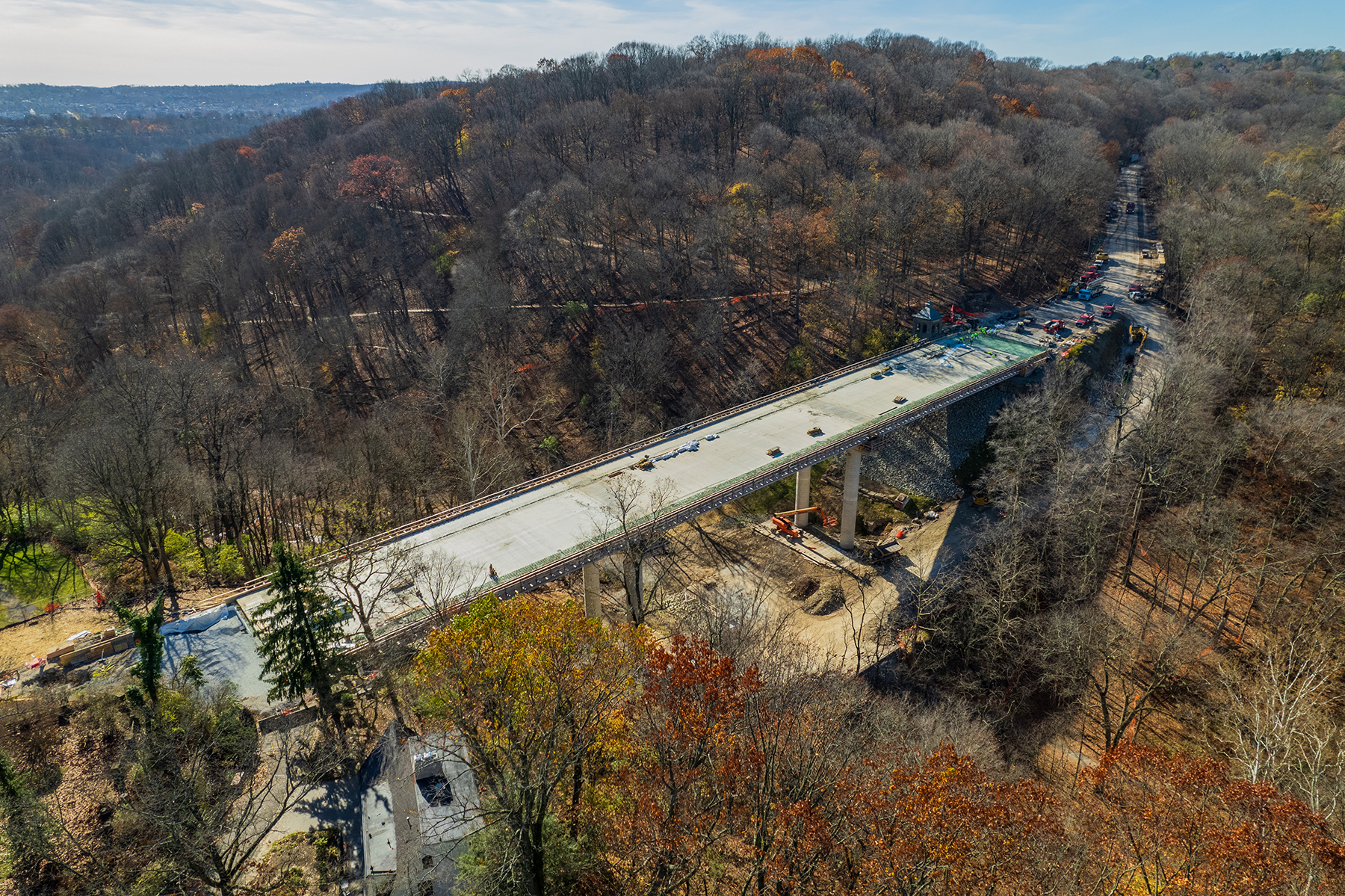
“At the time of the collapse, a 2013 New Flyer articulated bus, operated by the Port Authority of Allegheny County [now known as Pittsburgh Regional Transit] and four passenger vehicles were on the bridge,” according to the NTSB’s summary. “A fifth passenger vehicle drove off the east bridge abutment following the collapse and came to rest on its roof on the exposed ground below. As a result, 10 vehicle occupants sustained injuries.”
Immediately after the collapse, the priority was safety. Emergency personnel ensured that the people and vehicles caught on the bridge were safely removed and that there were no pedestrians under or on the bridge who were affected. The site was secured and inspected to ensure that no other surprises would jeopardize the nearby residents and traveling public.
The NTSB quickly began studying the collapse. The final results of the NTSB investigation are pending and independent of the replacement project.
As the cleanup started, the focus immediately turned to replacement. Ultimately, less than 11 months later, city and state officials cut the ribbon on a replacement bridge — a feat of fast-paced coordination, engineering, and construction that radically reduced the usual time frame for similar projects.
Gathering the team
Before its collapse, the 49-year-old bridge served as an important link for neighborhood residents, providing the only way to avoid having to circumnavigate the 644-acre Frick Park. It also carried emergency vehicles that would otherwise have had to drive an additional 20 minutes or more.
Understanding the need for swift action, Pennsylvania Gov. Tom Wolf and Pittsburgh Mayor Ed Gainey issued emergency declarations. As a result, the Pennsylvania Department of Transportation and the city of Pittsburgh were able to utilize all available powers, resources, and personnel deemed necessary to cope with the magnitude and severity of the bridge collapse.
Coincidentally, President Joe Biden was in Pittsburgh the day of the collapse to announce new infrastructure funding. He visited the site of the collapse, bringing even more attention to the already-high-profile event.
The city of Pittsburgh partnered with PennDOT on the emergency response and restoration, with the latter taking the lead because it could more quickly divert resources to the project.
Using emergency procedures, PennDOT chose Swank Construction Co. LLC as the contractor best able to build a replacement structure as quickly as possible. Swank also worked with the NTSB through the process of cleaning up the site. PennDOT selected HDR Inc. to serve as the engineer for Swank under a design-build contract.
The Infrastructure Investment and Jobs Act — which had passed just two months earlier, in November 2021 — helped provide flexibility for the project’s $25.3 million budget. In part because of the promise of new federal funding, PennDOT could quickly transfer funds that had been planned for other projects to the emergency rebuild.
Just five days after the collapse, the full team met for the first time to begin planning a replacement. As the effort continued, project management centered around weekly meetings, which were unique in their involvement of all levels of government and the project delivery team. They included representatives of the Federal Highway Administration within the U.S. DOT, PennDOT’s central office and district and design units (bridge, roadway, traffic, maintenance), the city of Pittsburgh, HDR, Swank, and major subconsultants.
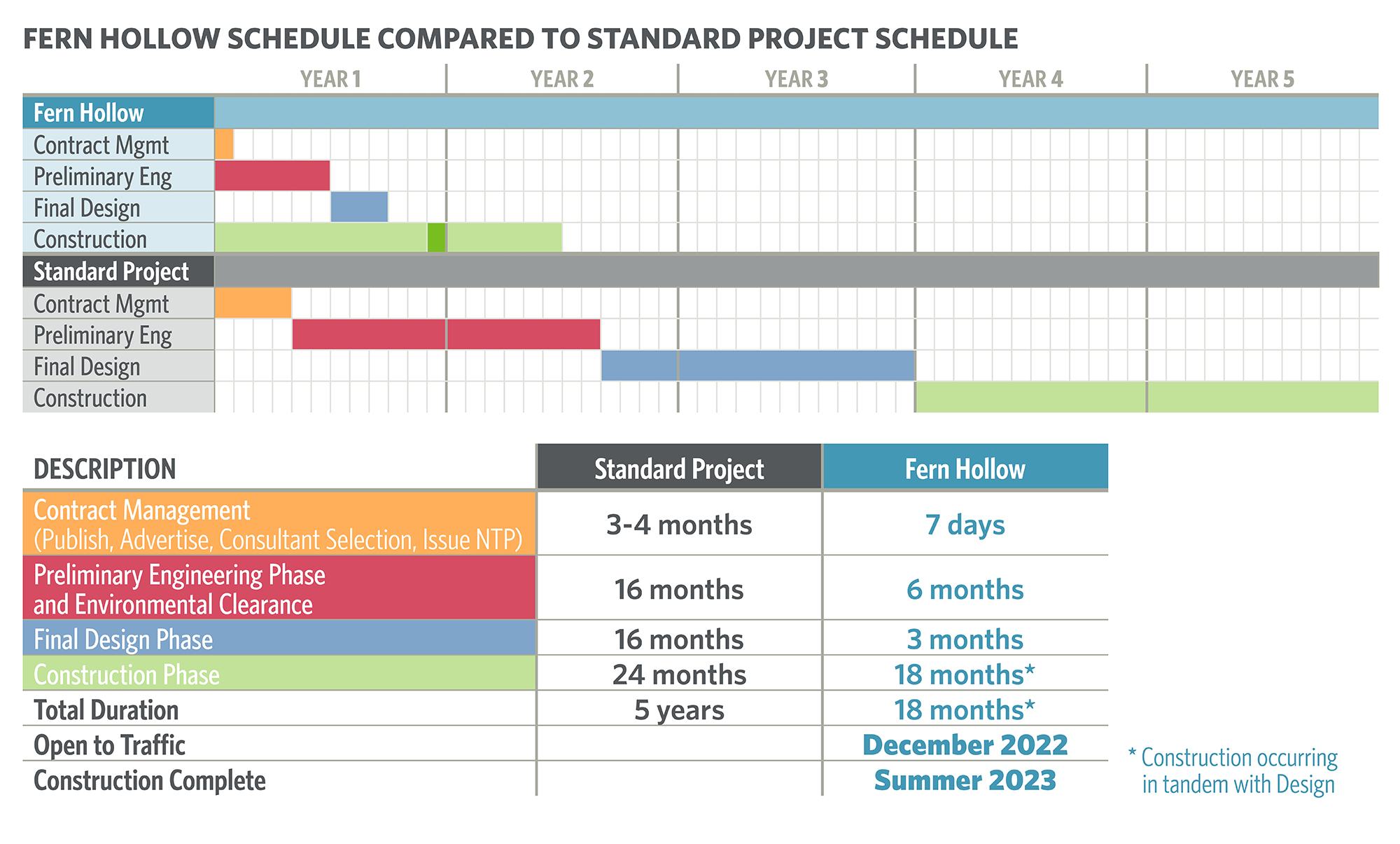
Conducted remotely, the meetings enabled everybody to participate, and all participants prioritized this as the key time for updates. This resulted in decisions that were properly considered, collaborative, and swift. Ultimately, this intensive collaboration is what enabled the project team to ready a replacement bridge by December.
Bridge design comes into focus
The project team made major design decisions in February, mere weeks after the collapse.
Reviewing the project site, the design team quickly identified major constraints: The venerable Frick Park Gatehouse, which dates to approximately 1935, is along the southwestern quadrant, and the Briar Cliff private drive and neighborhood is within the northeastern quadrant. Steep slopes in the remaining quadrants would have required significant retaining walls if the road was widened.
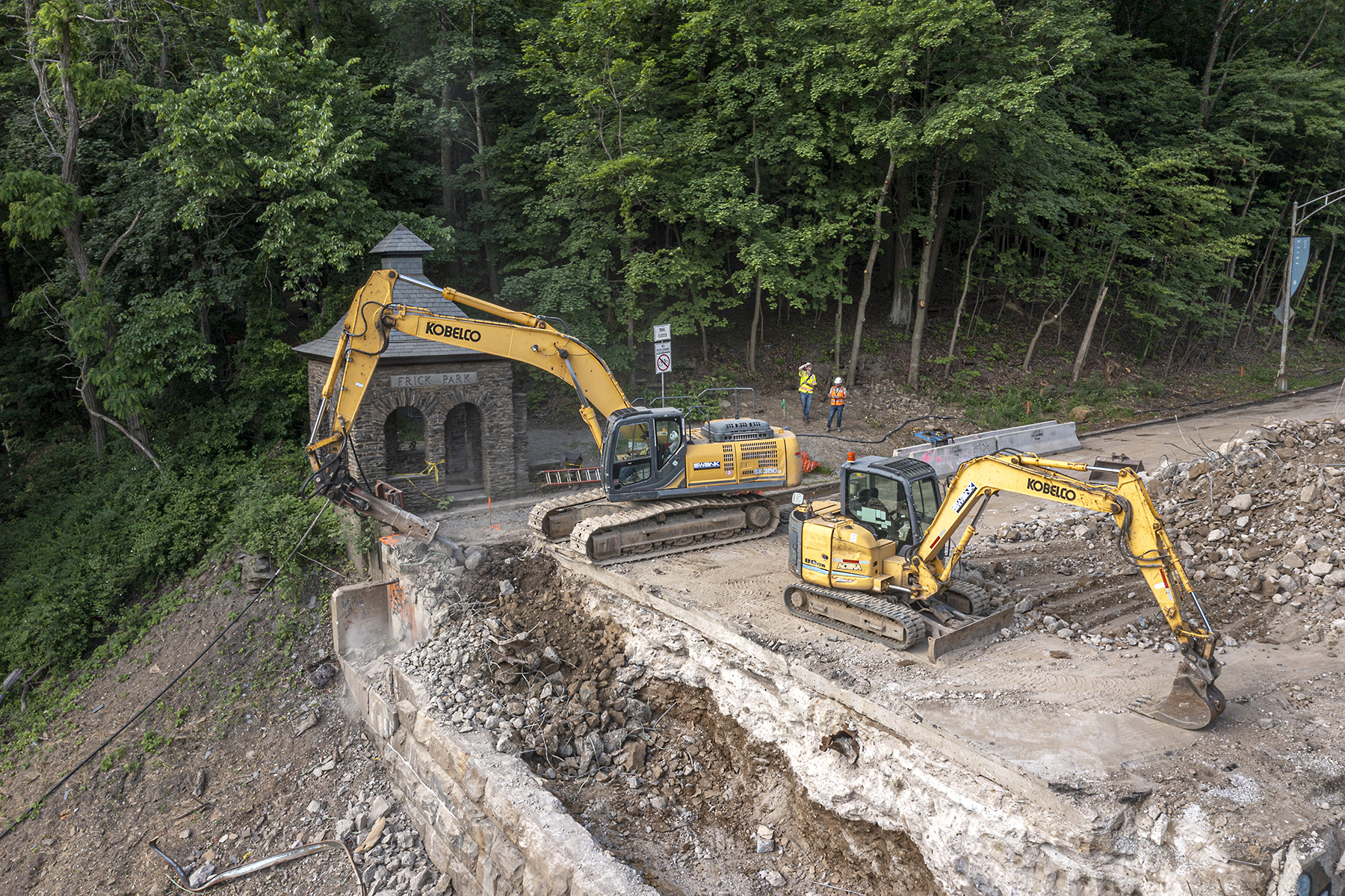
Because of these existing features and the desire to remain within the city of Pittsburgh’s existing limited width legal right of way, no changes to the existing alignment were feasible based on the accelerated schedule. With this knowledge, the team matched the 64 ft out-to-out width of the new bridge to that of the collapsed structure.
Quickly, the main decisions for the selected proposed structure came into focus. Located 100 ft above Frick Park, the new 460 ft long Fern Hollow Bridge features composite, prestressed-concrete Pennsylvania bulb-tee beams. The bridge consists of three spans made continuous by the deck and diaphragms to increase the capacity of the superstructure and eliminate joints to decrease future maintenance needs.
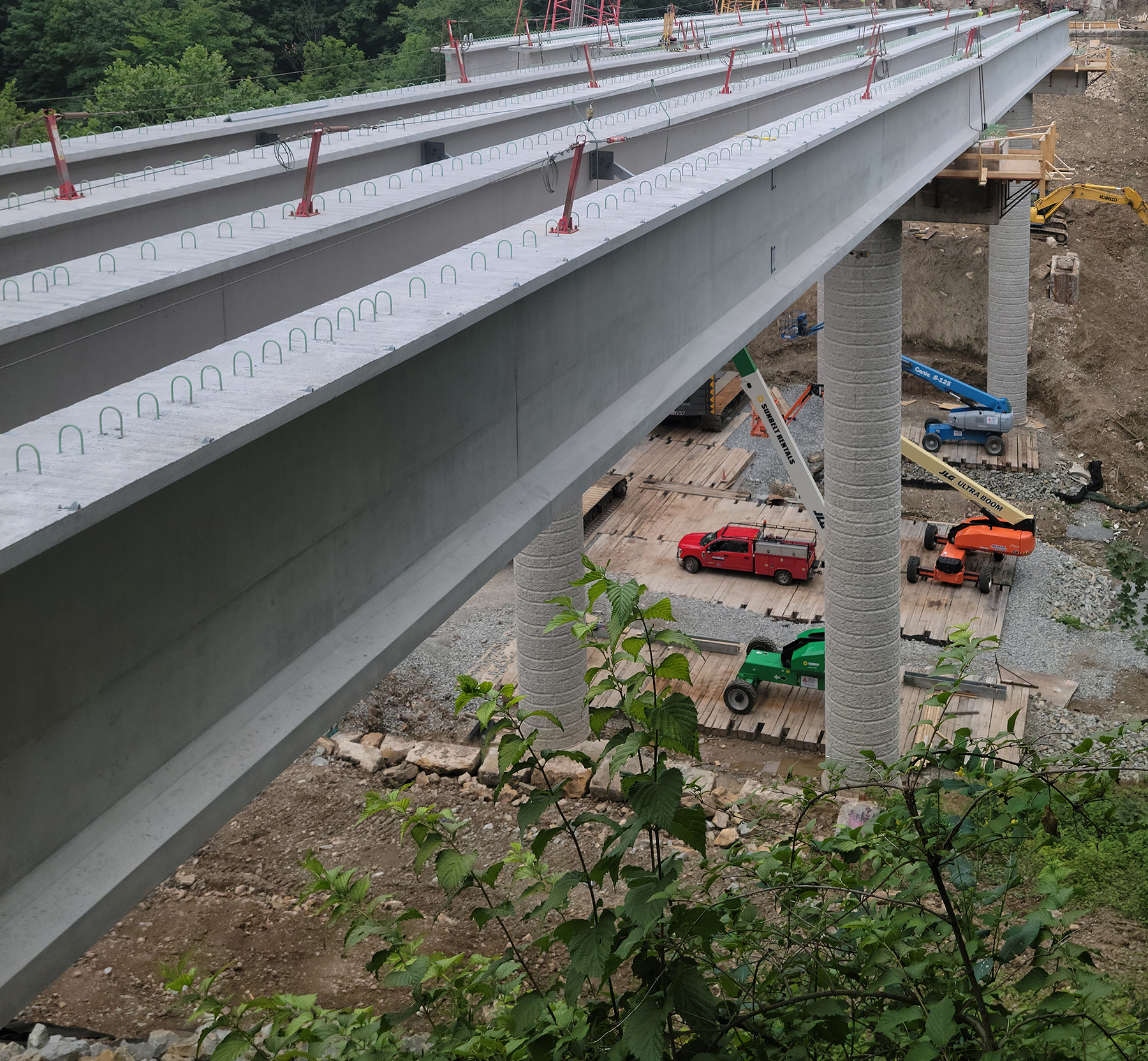
Additional design features of the new bridge include:
- A total of 21 Pennsylvania bulb-tee beams, each measuring 8 ft deep by 152 ft long and weighing more than 200,000 lb.
- A cross section having more than 15 ft of pedestrian and bicycle access width and four vehicular travel lanes.
- Two-column piers founded on 8.5 ft diameter drilled shafts.
- Integral abutments behind the original masonry abutments, which were retained.
Designing and constructing in parallel
Infrastructure design projects usually involve linear processes. In this case, given the urgency, the design team worked with PennDOT to determine what could be done in parallel, where data already available could be used, and when partial submissions could be submitted for review, rather than complete submissions.
HDR began designing the structure both from the top down (as is typical for bridges) and from the bottom up, relying on its knowledge of local geology as well as geotechnical data the firm had recently developed for a nearby bridge replacement project. Designing the bottom of the bridge and its foundation elements was important, given the speed of the project, as they were among the first items that needed to be constructed.
HDR accelerated this design process by making reasonable assumptions regarding site conditions. These assumptions were reviewed and accepted by PennDOT and Pittsburgh’s Department of Mobility and Infrastructure and confirmed as the project progressed.
The design team prioritized equipment and material that was on hand or available quickly. This strategy prompted the design team and Swank to determine that 8.5 ft diameter drilled shafts were the optimal solution to expedite construction, as Swank excels at self-performing drilled shaft construction.
In fact, the company had just recently acquired an LB 30 drilling rig, made by the Liebherr Group, that could be brought to the site quickly. This size drill rig had the 8.5 ft diameter tooling necessary for the project and possessed the capability to install the required shafts.
Had Swank not had the rig and the tooling that came with it on hand, procurement of the items would have delayed the job for weeks, if not months, because the drilled shafts had to be constructed first.
The drilled shafts are supported by 8 ft diameter rock sockets ranging from 14 ft to 17 ft deep. The piers founded on the 8.5 ft diameter shafts comprise two round 64 ft tall columns topped with 7.5 ft by 8.6 ft pier caps that span the bridge’s width.
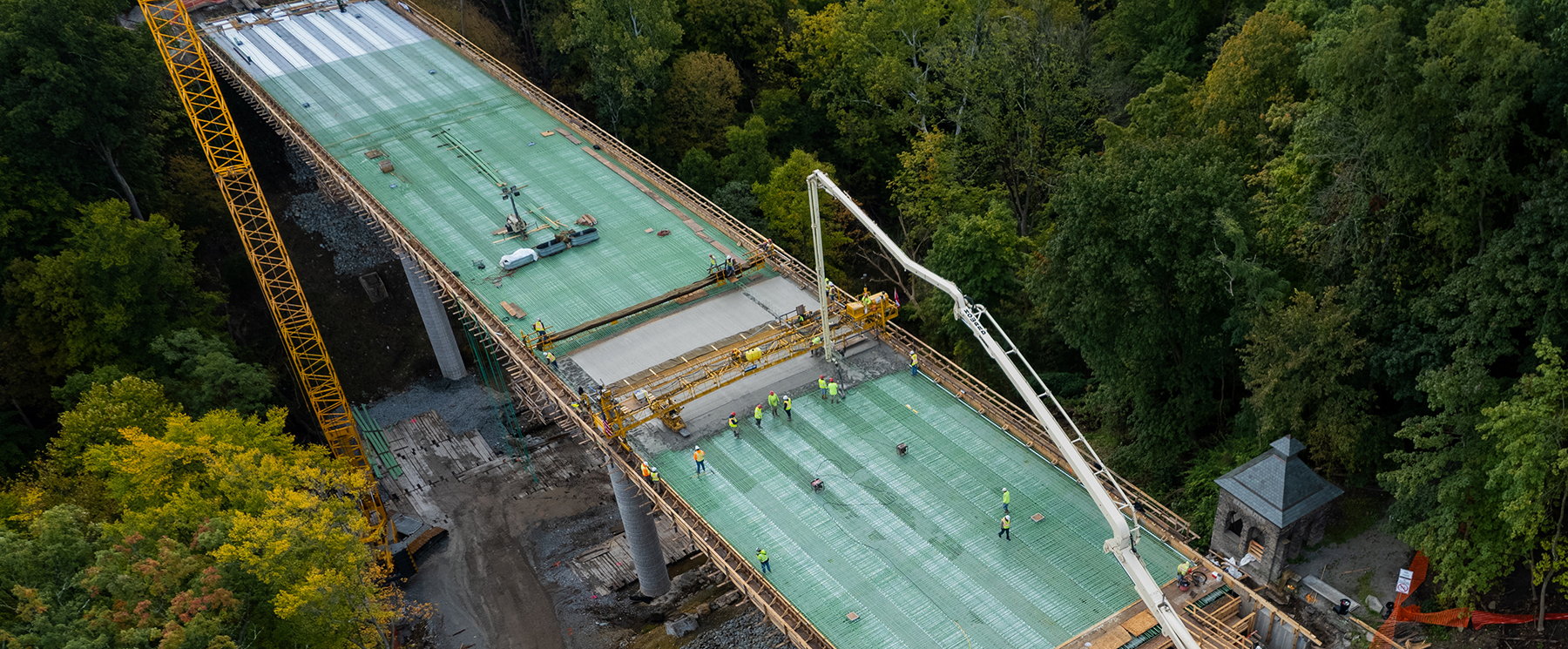
The overall work was divided into parcels, with the components likely to have longer lead times undertaken first. Design-build delivery required the team to design with procurement, fabrication, and construction in mind, so the contractor could start as soon as the winter weather cleared. The first of these packages included beams and bearings because they had the longest lead times for procurement. Then came the foundations because they would be the first items constructed. As work progressed, the project team kept delivery and construction on track through a just-in-time design approach.
Overall, the design-build process facilitated an incredible awareness of the effects of design decisions on construction and vice versa, which was only heightened by the high profile of the project. HDR and Swank’s teamwork, along with the timely input and reviews by PennDOT and the city, was evident in the results.
Community-informed improvements
Naturally, the local community was concerned about how the bridge would be restored to service and how the replacement structure could best serve current and future community needs. Early project discussions included the requisite bridge-type study that explored viable designs in both concrete and steel and established criteria for choosing the final design — but this study was completed in days instead of months.
The design team and contractor worked closely with PennDOT to use rough cost estimates and schedules, along with Swank’s availability estimates for materials, to develop realistic bridge configuration options for public discussion. The city of Pittsburgh participated throughout as discussions evolved, and its input as the bridge owner was critical during the design decision process.
The original bridge had 5 ft, 5 in. wide raised sidewalks on both sides. The community asked for improved bicycle and pedestrian amenities, and the design incorporated those wishes while retaining the same overall width and number of required traffic lanes of the collapsed bridge.
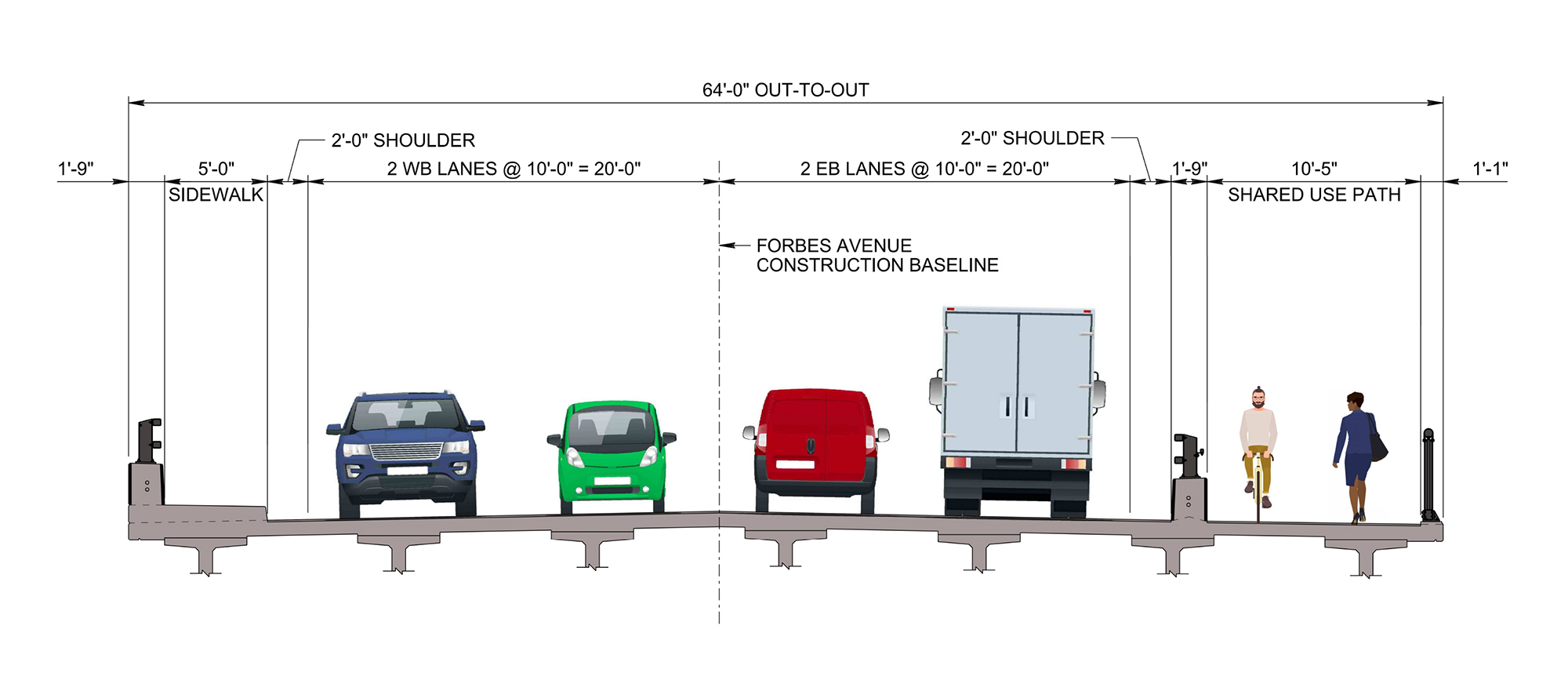
To do so, the new design narrowed the four traffic lanes from 11 ft to 10 ft and the shoulders from 3 ft to 2 ft to make way for a 10 ft., 5 in. wide shared-use path and a 5 ft wide raised sidewalk on the opposite side of the bridge. Combined, these changes increased the pedestrian and bike access across the bridge by 50%. A new pedestrian crosswalk extends perpendicular to the bridge at its west approach to enable pedestrians and bicyclists to safely cross the busy roadway when using the park’s trails and the roadway’s sidewalks and cycle tracks.
Reopened to traffic
On Dec. 21, the project team, along with local and state officials, cut the ribbon on the new bridge, just 327 days after the former bridge collapsed.
The day after the ribbon-cutting, the bridge opened to traffic. Work continues on some components, including a bridge deck overlay and lighting installation. Highlighting the accelerated nature of its design and construction, the entire project is scheduled to be complete this summer, approximately 18 months after its unexpected early morning collapse.
Jason Fuller, P.E., is a vice president and senior project manager for HDR Inc. and led HDR’s efforts on the Fern Hollow Bridge.
This article first appeared in Civil Engineering Online.
Project credits
Owner City of Pittsburgh and Pennsylvania Department of Transportation District 11
Designer HDR Inc.
Contractor Swank Construction Co. LLC



